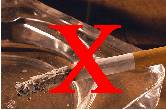 |
 |
 |

Photos of Smokers Trigger Brain Reaction in Those Trying to Quit
Imaging study shows why cigarettes are so hard to abandon|
|
HealthDay
By Kevin McKeever
Monday, January 12, 2009
 MONDAY, Jan. 12 (HealthDay News) -- If you're trying to quit smoking, just looking at a picture of someone taking a puff could hurt your attempt to kick the habit, a new study says.
MONDAY, Jan. 12 (HealthDay News) -- If you're trying to quit smoking, just looking at a picture of someone taking a puff could hurt your attempt to kick the habit, a new study says.
Brain scans of smokers taken before and 24 hours after quitting showed increased activity in certain areas of the brain that cue the person to crave a drag when they view photographs of others smoking, according to research published online Jan. 5 in Psychopharmacology.
"We saw activation in the dorsal striatum, an area involved in learning habits or things we do by rote, like riding a bike or brushing our teeth. Our research shows us that when smokers encounter these cues after quitting, it activates the area of the brain responsible for automatic responses. That means quitting smoking may not be a matter of conscious control," researcher Joseph McClernon, an associate professor in the department of psychiatry and behavioral sciences at Duke University Medical Center, said in a news release issued by the school.
"So, if we're really going to help people quit, this emphasizes the need to do more than tell people to resist temptation. We also have to help them break that habitual response," he added.
"Only five percent of unaided quit attempts result in successful abstinence," McClernon said. "Most smokers who try to quit return to smoking again. We are trying to understand how that process works in the brain, and this research brings us one step closer."
Study co-author Jed Rose, director of the Duke Center for Nicotine and Smoking Cessation Research, said previous research he conducted showed that wearing a nicotine patch and smoking a cigarette with no nicotine breaks the learned behavior.
"The smoking behavior is not reinforced, because the act of smoking is not leading them to get the nicotine," Rose said in the news release. "Doing this before people actually quit helps them break the habit so they start smoking less. We're seeing people quit longer this way."
HealthDay
Copyright (c) 2009 ScoutNews, LLC. All rights reserved.
Related News:
More News on this Date
Related MedlinePlus Pages:
| Home | Health Topics | Drugs & Supplements | Encyclopedia | Dictionary | News | Directories | Other Resources | |
| Disclaimers | Copyright | Privacy | Accessibility | Quality Guidelines U.S. National Library of Medicine, 8600 Rockville Pike, Bethesda, MD 20894 National Institutes of Health | Department of Health & Human Services |
Date last updated: 13 January 2009 |




